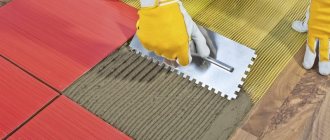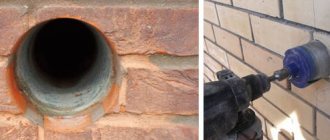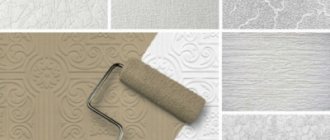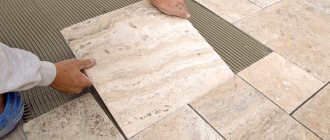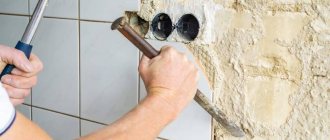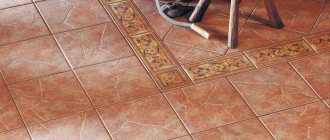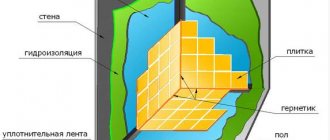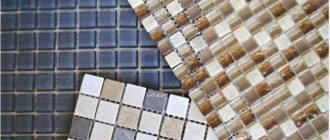Narrow holes for installing dowels
When an apartment owner decides to equip a bathroom with wall-mounted devices, he has to fix them on tiles that have long been firmly attached to the surfaces of the bathroom. In this case, the grooves required are not very large, sufficient to accommodate dowels with a diameter of 4 to 12 mm.
If the homeowner decides to equip the bathroom with a rosette, then the corresponding grooves are made before the cladding begins.
In such cases, a pipe comes out of the architectural elements of the room for supplying cold or hot water, draining sewage, and there is also a ventilation duct there.
Which drill bits are best for drilling tiles?
The quality of the hole made in the tile largely determines the choice of drill. We can say that this is the main point in preparing for drilling ceramic tiles.
First you need to find out the parameters of the tile, primarily its thickness and hardness. Wall tiles and porcelain floor tiles may require different drill bits.
For example, diamond drills are used to drill porcelain stoneware and ceramics. Drilling depth - 35 mm. A set of three pieces of domestic diamond drills of different diameters costs from 1,300 rubles. It is believed that diamond drill bits are most suitable for drilling tiles. But they have a high price and it is reasonable to buy them only for significant volumes of work.
Pobedit drills are cheaper than diamond drills. Such a drill has a soldered plate of durable hard metal at the end, which is called “WIN”. It is an alloy of tungsten and cobalt in a ratio of 90% to 10%. Nowadays, tips are most often made from tungsten carbide. These drills are most often used when working with tiles.
To make small holes, in particular for dowels, drills with a spear-shaped tip or drills with four cutting blades are used. Water cooling is recommended for all of them. The price of pobedit drills is 200-300 rubles per piece.
Crowns for tiles with diamond coating. There are different diameters, starting from 5 mm. They are used to make significant holes when it is necessary to install sockets, pipes, or install a toilet in the floor. They are most often sold in sets and cost from 1,500 rubles.
There is another option in the form of crowns with cutting edges made of pobedit. Such a crown looks like a hollow cylinder with a drill in the center. There are cutting edges on the cylinder walls. The result of drilling is a ring, inside of which is untouched tile material. After drilling, it is shaken out of the crown. The diameter of the largest crowns is 15 centimeters. This is enough for holes for the largest pipes, including sewer pipes. It will not be possible to achieve a particularly clean opening with such a crown; the edges of the holes are not very smooth. Its resource is enough for 20 holes.
Circular drills (ballerinas for tiles). The design of the ballerina consists of a feather centering drill and a cutter on a bracket, with the help of which the diameter of the hole being made is set.
The ballerina is secured into the drill chuck using a rod. The cutter has a spear-shaped shape, is made of hard alloy, and can also be coated with diamond. The tool is inexpensive, its price starts from 345 rubles. This is a definite plus of the equipment. In practice, the ballerina replaces a whole set of crowns of different diameters on the tile.
Despite the apparent simplicity of the device, working with a ballerina is not easy compared to using a hammer drill or drill.
Drills with a pobedit tip for concrete are used if the above tools are not available. A concrete drill can be found in almost every home. But to drill through tiles, you must use only a sharp drill bit, and drill carefully, since its shape is not entirely suitable for such work.
Self-tapping screws with LM tip. Wall tiles can be drilled without a drill by screwing in the indicated screws. But this work is very labor-intensive; one hole will take 2-3 self-tapping screws.
In principle, in practice you can use expensive diamond drills, you can use Pobedit or ordinary SDS drills for concrete - the difference is almost not noticeable. The main thing is to avoid impact mode when drilling tiles, use minimum speed, but when the ceramic material has been drilled through, switch to impact mode and drill the opening to the end.
When choosing a drill, you need to pay attention to the type of shank of the drill, whether it will fit your drill. Drills come with a cylindrical shank and some with a hex shank. This shank is more securely fixed both in the three-jaw chuck and in the drill bit holder.
Drilling methods used in the bathroom
If the equipment being mounted is massive or large-sized, then wide holes will be required for it. In this case, the following drilling methods are used:
- Through crowns;
- Using a diamond blade.
How to drill floor tiles?
For drilling, you should definitely not use a mechanical drill , although you can come across such advice, even one hole will require a lot of force, and it is quite difficult to maintain the straightness of the drill.
You can use both a household electric drill and a professional one, but you should not use Soviet-made drills ; such models do not have the ability to start the engine smoothly.
The greatest difficulty is drilling through the glaze layer ; the drill cannot be fixed in the right place. To do this, you need to mark the passage with a hardened self-tapping screw, lightly hitting it with a hammer several times, this is quite enough to destroy the glaze.
also stick on a medical plaster , which will easily hold the drill in place. Drilling begins at low speeds, but only in drill mode; after passing the glaze layer, you can reach maximum speed.
After the drill exits the tile onto the concrete, if drilling needs to be continued, switch the tool to hammer drill mode. must be cooled in water after each pass .
Hole for mirrors and shelves
To drill grooves with a diameter of about 10 mm, only narrow working nozzles are used. However, they can differ significantly in design.
When carrying out such work you will need:
- Household or professional construction drill;
- At least the simplest hammer drill;
- Portable screw driver with variable chuck speed.
Drilling tiles that are not glued to the wall
To carry out work with tiles that will only be laid on the wall, it is necessary to equip a workplace. The surface on which the work is carried out must be smooth; you can use a workbench, a wooden board, a sheet of thick plywood or plasterboard.
- Before carrying out work, the tiles are soaked by placing them in water for 30 minutes.
- The tiles are placed on a clean, smooth surface.
- Apply masking tape to the location of the intended hole.
- Markings are made, taking into account a distance from the edge of the tile of at least 15 mm. Make a mark with a construction pencil.
- It is better to fix the tiles with a clamp. Drilling begins with a drill at the lowest speed, without applying excessive pressure on the tool.
- Particular attention should be paid to holding the apparatus at a right angle to the plane of the ceramic tile.
Features of markings on glossy tiles
The installation procedure for making grooves is divided into several stages. First, at low speed, a hole is drilled in the ceramic decorative material. Then a groove is made in the wall or floor covering. Regardless of the design of the drill, you should check how carefully the cutting edges are sharpened.
It is almost impossible to mark carefully polished tiles with a lead pencil or felt-tip pen, so this operation is carried out using strips of adhesive tape or narrow tape.
Tools for work
To properly make a hole in the wall without deforming it, you need to choose the right tools. You should have on hand:
- Drill
- Drill
- Insulating tape
- Felt pen
- Vacuum cleaner for collecting dust
If you need to make a hole in a tile on a wall of large diameter, a ballerina drill is often used.
They also use round drills with cutters, which, using a hexagon, are installed at the same distance from the center. The cutters move at different distances, so you can easily make a hole of the desired size. Mark the required parameters and, holding the tile firmly, drill at low speeds. The price of such a tool is low; you can purchase it at any hardware store.
Important! It is necessary to work with a ballerina drill at low speed, holding the tile tightly so that possible fragments from under the drill do not touch you. While drilling, try not to jerk the working tool; you can use a special tripod to strengthen the position.
The main differences between spear-shaped attachments
A nozzle with two blades must be sharpened when the working edges wear down to a certain level, which significantly reduces productivity.
Such equipment is quite affordable, since the 6 mm version costs about sixty rubles. The work is progressing at high speed.
- As for the four-blade version, it will no longer be possible to sharpen it as easily and quickly as its two-blade counterpart.
- The cost in this case will be much higher, because a drill with a diameter of 5 millimeters will cost one hundred and seventy rubles.
It is easy to conclude that it is a disposable nozzle, but not cheap at all.
Basic principles of drilling ceramic tiles
In the practice of drilling ceramic tiles, there are general operating principles:
- Drilling must be carried out with a sharply sharpened drill. If it is not sharpened properly, no amount of tricks with a tool, masking tape, or chipping the glaze will help. A dull drill heats up faster during operation and begins to be unable to cope with the material. If it is not sharpened in time, overheating will only intensify, which in turn will quickly lead to complete wear of the equipment. With every second, the tool will work slower and you will need to press it harder, which can lead to destruction of the material.
- Therefore, you need to use either a new drill, or check its sharpness, and sharpen it if necessary. Professional craftsmen usually sharpen drills every day. To sharpen a drill, you need a machine and an emery wheel; for a Pobedit drill, you need a diamond wheel and coolant.
When drilling tiles, the general rule is “The harder the material, the lower the speed.”
- Before the drilling operation, the shock mode in the drill is turned off and the speed is set to the lowest possible speed. The drilling itself should be performed at low drill speeds, usually from 200 to 800 rpm. The optimal speed is selected experimentally and depends on the type of drill, its diameter, thickness and composition of the material being drilled.
- You cannot press the drill too hard while drilling, but applying too little pressure will delay the process. With experience comes the optimal application of force on the instrument.
For beginners, it makes sense to try the process on tile scraps in order to feel the correct position of the drill and the required application of force during the operation.
- Do not allow the drill and tile to overheat, which may damage the tile. Water is used to cool the drilling site. The drill is dipped in cold water and then wiped dry. Cooling has a significant effect on increasing the life of equipment.
- It is unacceptable to change the direction of rotation of the drill while drilling.
- The drilling location should not be located near the edge of the tile.
- While working with tiles, small fragments of material may fly away. Therefore, we should not forget about safety measures: work on drilling tiles is carried out with protective glasses and gloves.
Accurate hole marking without core
None of these drill bits are suitable for drilling into brick or concrete masonry. That is why, after these attachments pass through the tiles, it will be necessary to install a hammer drill in the drill.
A similar attachment for a drill equipped with an impact function is also quite suitable.
- Due to the fact that the final part of the spear is not much inferior in sharpness to the core, in this case marking the hole with a core will not be necessary.
- You just need to accurately position the drill at the site of the future hole, lightly hit its body, and it will make a deepening sufficient to continue the operation.
Drilling technique
The purposes of drilling tiles can be very different - from creating a small hole for a screw to drilling an entire circle for a pipe or socket.
Large holes
The best option for creating capacious perforation is to use a ballerina with a tip of the required diameter. It is recommended to first practice on waste tiles in order to “feel” the tool. If a ballerina is not at hand, a hole saw will come to the rescue, which even an owner inexperienced in construction can successfully handle.
Another method of drilling step by step:
- Mark the center of the planned hole and draw a circle of the required diameter.
- Using any tile drill, make several holes along the diameter of the circle, trying to place them close to each other.
- The drilled sectors are carefully pressed, and the remaining pieces are removed with wire cutters.
- The edges are sanded to give the correct shape.
Small holes
Step-by-step instruction:
- Marks are placed on the surface of the ceramic for the hole.
- To prevent the drill from slipping, stick masking tape or lightly chip off the enamel in the center of the future hole.
- Disable the impact mode function on the drill and connect the device to the network.
- Place the drill at an angle of 90° to the tile and start drilling at low speed.
- Gradually the speed is increased, punching the tile to the very base.
- Change the drill to a new one, suitable for the type of wall base (concrete, brick, wood) and continue drilling to the required depth.
The diameter of the second drill should not exceed the size of the first, otherwise the tile will be damaged.
Impactless drilling of tiles
Working attachments are made from a hard material called pobedit. At the same time, the configuration of the working area is designed so that it allows quick and error-free penetration into solid materials such as concrete walls and brickwork.
- To avoid damaging the fragile ceramic lining, you should not use the impact function when drilling it.
- The cartridge should rotate at a speed of eight hundred to nine hundred revolutions per minute.
- It is better if a new drill that has never been used before is used for this work.
It is important to be aware that this method is only applicable to ordinary tiles.
How to drill through tiles?
What tasks are most often pursued when drilling ceramic finishes:
- laying water pipes or other communications;
- installation of an electrical outlet;
- hanging shelves, mirrors, hooks and holders;
- heated towel rail insert;
- installation of a clothes dryer.
Before starting drilling, determine the type and quality of the tile. Density, strength, fragility, glaze characteristics and porosity of the tile - all these factors influence the outcome of the drilling process and the choice of tool.
But almost all types of tiles are characterized by one feature - a slippery surface from which the drill will constantly slide. Solving the problem is simple - just cover the working area of the drill with masking tape and get to work.
Another nuance is assessing the density of the tiles. Tap lightly on the facing surface. A dull sound will indicate the absence of voids in the coating - it can be drilled. If the sound is ringing, there are cavities in the tile, which, when drilled, can lead to breaks and chips.
Impact drilling of porcelain tiles
If you have to deal with porcelain stoneware, it will be quite difficult to do without using the impact function, because the cutting ability of the drill alone will not be enough to achieve the goal.
Regardless of the width of the drill, its tip tends to slide off the selected location. This is the peculiarity of glossy tiles.
Spear drills
A fairly common option used for processing fragile surfaces. How to drill tiles without cracking? – these drills know the answer to this question. The main advantage over others is durability. These drills are great for drilling slots for dowels to install towel dryers, rollers and hangers. They are also used for work on glass and mirrors. The low cost of the drill and the high quality of the work performed make the tool very attractive.
Marking the hole using improvised means
Often, to apply markings for drilling, it is quite enough to slightly destroy the enamel with a steel drawing pencil or a fairly sharp self-tapping screw. This operation will allow, even when using a low-power drill, to achieve accurate and error-free penetration into ceramics of any structure.
A drill equipped with a round shank will cost thirty to fifty rubles. A simple hammer drill will cost fifty to seventy rubles.
Drilling small diameter holes
To hang mirrors, shelves, kitchen or bathroom accessories on the wall, use dowels with a diameter of up to 1.2 cm. In this case, drilling ceramic tiles on the wall is carried out provided that the glue under the coating has already hardened.
Important! Choose a location for attaching attachments so that the holes are located no closer than 1.5 cm from the edge of the tile. This will avoid chips and cracks.
We carry out the work in the following sequence:
- the diameter of the drill should be 1-2 mm larger than the diameter of the dowel;
- place the drill exactly in the center of the marking and start working at low speeds;
- after passing the tile, the drill is removed and replaced with a tool for perforating walls (its diameter must correspond to the cross-section of the dowel);
- it is important to ensure that misalignment of the drill does not cause damage to the tiles;
- then carefully drive in the dowel and screw in the self-tapping screw.
Modifications of tubular drilling attachments
Cylindrical drill bits are divided into the following two types:
- Conventional, which is a tube equipped with a groove for shaking out drilled powder and diamond coating at the end;
- Sector, which is a cylinder in which a sector is cut out, inside of which there is a diamond coating.
An ordinary tubular drill is an analogue of a crown. The destruction of the medium is carried out along the contour of the outer ring, the central part is removed after completion of the working cycle.
The cost of a tubular drill is determined by the method of applying the working diamond layer and ranges from two hundred and fifty to three hundred and fifty rubles.
Tool selection
Whatever tool you choose, you should remember that the maximum number of revolutions should not exceed a thousand. Professionals advise choosing a cordless screwdriver, its power is optimal from eight hundred to a thousand revolutions. A good replacement could be a mains-powered screwdriver; its technical characteristics are similar to a battery-powered one. It happens that the household does not have the necessary electric tools. No problem, you can use a hand drill. The price for it is quite affordable, and a small number of revolutions, which can be worked out by hand, will allow you to get a hole of the ideal size.
IMPORTANT! Remember that a hand screwdriver is ideal when you need to make a hole no larger than 3 millimeters. An important point is the choice of drills. Let's figure out how to choose.
Types of drills for tiles
Divided into:
- Spear-shaped.
- Made of hard alloys with one-sided sharpening.
- Diamond.
- Coated with carbide and tungsten.
- "Ballerina".
